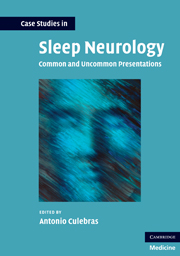Book contents
- Case Studies in Sleep Neurology
- Case Studies in Sleep Neurology
- Copyright page
- Dedication
- Contents
- ContentsThe following cases described herein have been published previously
- Foreword
- Contributors
- Abbreviations
- Introduction
- Part I Sleep-related breathing disorders
- Part II Hypersomnias of central origin
- Part III Circadian rhythm disorders
- Part IV Parasomnias
- Part V Sleep-related epilepsy
- Case 25 The anxious hitting sleeper
- Case 26 Bad dreams
- Case 27 Sleepwalking or seizing?
- Case 28 Seizure, parasomnia or behavioral disorder?
- Case 29 Sounds of choking at night
- Case 30 Fighting in sleep
- Part VI Sleep and stroke
- Part VII Sleep-related movement disorders
- Part VIII Neuromuscular disorders and sleep
- Appendix: Epworth Sleepiness Scale
- Index
Case 27 - Sleepwalking or seizing?
from Part V - Sleep-related epilepsy
Published online by Cambridge University Press: 10 November 2010
- Case Studies in Sleep Neurology
- Case Studies in Sleep Neurology
- Copyright page
- Dedication
- Contents
- ContentsThe following cases described herein have been published previously
- Foreword
- Contributors
- Abbreviations
- Introduction
- Part I Sleep-related breathing disorders
- Part II Hypersomnias of central origin
- Part III Circadian rhythm disorders
- Part IV Parasomnias
- Part V Sleep-related epilepsy
- Case 25 The anxious hitting sleeper
- Case 26 Bad dreams
- Case 27 Sleepwalking or seizing?
- Case 28 Seizure, parasomnia or behavioral disorder?
- Case 29 Sounds of choking at night
- Case 30 Fighting in sleep
- Part VI Sleep and stroke
- Part VII Sleep-related movement disorders
- Part VIII Neuromuscular disorders and sleep
- Appendix: Epworth Sleepiness Scale
- Index
Summary
Keywords
- Type
- Chapter
- Information
- Case Studies in Sleep NeurologyCommon and Uncommon Presentations, pp. 185 - 192Publisher: Cambridge University PressPrint publication year: 2010

